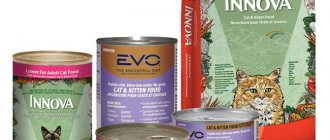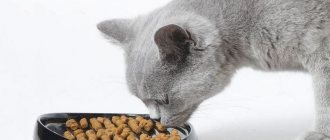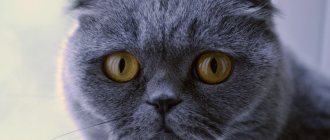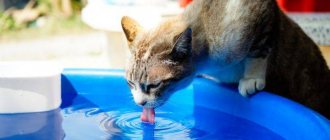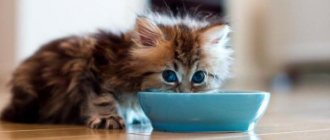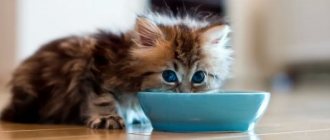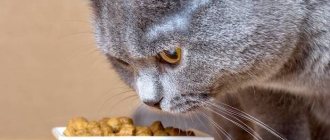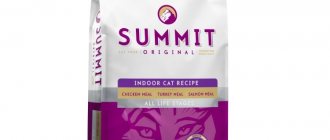About products
The rating of wet food for adult cats includes 20 TM products. These are economy and premium segment food produced in Russia (16 TM), Czech Republic (1 TM), France (2 TM) and Thailand (1 TM). The list included wet food in three formats: pate, pieces in jelly and pieces in sauce. The moisture content of these feeds varies from 76 to 85%. None of the goods are produced according to GOST. The goods are manufactured according to our own technical specifications (TS) or other regulatory documents. Feeds 15 TM are declared as complete rations, one is intended for an additional diet, on four feeds there is no message about completeness/non-completeness.
Of these foods, 19 are intended for healthy cats that do not have any pathologies, one is intended for dietary nutrition. This food was taken into the sample for the purpose of comparison; in the future, Roskachestvo will study other food in this category. An analysis of wet cat food showed that even the special purpose of the food does not guarantee the buyer the authenticity of the labeling. Details in product cards.
Package weight – from 85 to 415 g. Purchase cost – from 7 to 160 rubles per 100 g.
Previously, Roskachestvo examined dry cat food. Details HERE
.
The food tested was poultry flavored, namely chicken (2), as it is the most popular. This was confirmed by the results of a survey of visitors to our portals and social networks. Poultry food (chicken, turkey, etc.) is purchased by 71% of respondents. We thank everyone who takes part in Roskachestvo surveys!
Russian quality system standard
The standard of the Russian quality system for wet food (for cats), applying for the Russian Quality Mark, has established advanced requirements for the amount of dry matter, mass fraction of protein, moisture (at least 60%), raw ash, calcium, fiber and phosphorus, as well as acid and peroxide number of fat. The standard sets standards for the content of amino acids, vitamins and microelements. According to the standard, preservatives (sorbic and benzoic acids) and dyes are not allowed in cat food.
The testing program additionally included determination of the content of histamine, GMOs, antibiotics and pesticides in feed.
Products that comply with the standards specified in the STO have the right to apply for the Russian Quality Mark. The level of localization of production for the assignment of the Russian Quality Mark must be at least 70% of the cost of the product.
The requirements of the Roskachestvo standard are voluntary and are not mandatory for the manufacturer. If the product meets the advanced requirements of the Roskachestvo standard, the manufacturer receives the right to apply for product labeling with the Russian Quality Mark.
Economy class
Thanks to advertising and low cost, the demand for these products is simply huge. The composition of dry or soft cat food in this class includes mainly cereals, cellulose and by-products. Meat is present in a minimal amount - no more than 5%. Preservatives in such feeds are significantly overestimated. There are also dyes, thickeners and preservatives that are prohibited from being used in foods. Cat food, unfortunately, is not such a product. There is no strict control of supervisory authorities over manufacturers. It exists only in some countries, but different products enter the domestic market.
The most popular economy class foods: Felix, Darling, Cat Chow, Kitekat, Whiskas, All Cats, “Vaska”, “Nasha Marka” and others.
All food is fresh and safe. Almost
Safety
During the inspection of wet cat food, no violations were identified in terms of chemical and microbiological safety. All studied products comply with mandatory safety requirements, namely Veterinary and Sanitary Standards and requirements for the quality of feed for non-productive animals (approved by the Veterinary Department of the Ministry of Agriculture and Food of the Russian Federation on July 15, 1997 No. 13-7-2/1010).
However, there are no legal standards for the content of antibiotics and pesticides for cat food. Roskachestvo has established advanced requirements for these indicators. Isolated cases have been identified.
- The pesticide pirimiphos-methyl was found in one feed in an amount of 0.032 mg/kg. Previously, Roskachestvo detected this pesticide in almost the same quantities in Borodino bread
. By the way, this pesticide is also not regulated in bread.
Fedor Borisov
Executive Director of the Pet Food Manufacturers Association
– The manufacturing company audits each supplier of raw materials for compliance with the legislation of the Russian Federation and the requirements of the pet food industry. Suppliers use pesticides in accordance with Russian regulations. The residual content of pesticides is checked by chemical analyzes of raw materials. This ensures that the residual level of pesticides in raw materials complies with the requirements of the legislation of the Russian Federation.
- The antibiotic chloramphenicol (chloramphenicol) was detected in one feed in an amount of 4.71 mcg/kg (or 0.00471 mg/kg). It is not standardized in feed, so we can only talk about trace amounts of this antibiotic.
However, according to TR CU 021/2011, in food products for humans, in particular in meat, milk, meat and dairy products, this antibiotic is allowed only in trace quantities - less than 0.0003 mg/kg. Thus, the amount of antibiotic found in the feed exceeds the permissible “human norms” by 16 times. However, we repeat, this antibiotic is not legally regulated for cat food. And the requirements of TR CU 021/2011 “On the safety of food products” apply only to food products for people.
Sergei Kolomiets
veterinarian, head of the department of feeding and feed production of the Federal State Budgetary Educational Institution of Higher Education "Moscow State Academy of Veterinary Medicine and Biotechnology - MBA named after K. I. Scriabin" (FSBEI HE MGAVMiB - MBA named after K. I. Scriabin), Doctor of Biological Sciences
– Pesticides can get into food from cereals, vegetables, and grains. The manufacturer must check incoming raw materials to ensure that pesticides do not end up in the finished product. As for food with an antibiotic: if a cat constantly eats such food, then hypothetically its body may develop resistance to the antibiotic, and subsequently the treatment prescribed by the veterinarian may be ineffective. And inexpensive chloramphenicol is often used in the treatment of animals.
Let us remind you that only those products that do not contain any traces of antibiotics or pesticides can apply for the Russian Quality Mark.
– Meat raw materials used for the production of canned food are either classified as food raw materials, or are purchased from manufacturers who supply food enterprises with raw materials. Thus, raw meat producers monitor the content of antibiotics, the level of which complies with legal requirements, adds Fedor Borisov
. – – The manufacturer of high-quality wet cat food, in turn, on an ongoing basis carries out the necessary measures to check and monitor the reliability of its suppliers, including with regard to the quality and safety of the supplied raw materials.
The discovery of an antibiotic (and one that is not legally regulated) is an isolated case; overall, the study confirms the high quality of the raw materials used to make pet food. (No traces of antibiotics were found in the products of 19 brands. – Ed.)
Freshness
Whether the food is fresh or rancid, spoiled - indicators such as acid (mg KOH per 1 g of fat) and peroxide value of fat (1/2O mmol/kg), as well as histamine content can tell this. Again, there are no legal restrictions. The requirements for these indicators are established by the Roskachestvo standard: the acid number of fat is no more than 30, and the peroxide number is no more than 23.6. For all products, these numbers were very low, which indicates the freshness of the products.
No histamine was detected in the feed (at the detection limit).
Can the food be considered complete?
Pet owners often pay attention to marketing labels on food bags: “rich in vitamins,” “balanced nutrition,” “comprehensive health care,” “healthy pet today and tomorrow,” “natural and healthy,” “helps improve digestion and stool quality.” “... Seeing such inscriptions, the owners think that their beloved cat will receive everything he needs. And a number of buyers prefer only that food that is declared as complete. But what is hidden behind these promises?
What is a complete food?
This is a type of industrial feed that contains all the nutrients, vitamins and microelements necessary for animals. If your cat does not have health problems, then this food does not require any additional vitamins or nutritional supplements to be added to the diet.
Physico-chemical indicators of complete food for cats and dogs are reflected in GOST R 55453-2013 “Feed for non-productive animals. General technical conditions" (Table 2).
If food manufactured in accordance with GOST does not meet all indicators, then it is incomplete, and this must be indicated on the label.
However, none of the products studied are manufactured in accordance with GOST, which means that the manufacturer has the legal right not to indicate on the label that its food is non-complete. At the same time, the inscriptions “rich in vitamins”, “comprehensive care”, etc. do not confirm complete nutrition. In some cases, even the inscription “complete” will not give the buyer guarantees that the food is balanced and healthy.
By the way, GOST is quite democratic in terms of requirements for complete nutrition: it includes requirements for only 15 main indicators (for example, it standardizes only A, D, E for vitamins, but nothing is said about other vitamins). But in the collection of the European Federation of Pet Food Manufacturers (FEDIAF), there are much more requirements, and they are stricter.
Let us remind you that when developing the Roskachestvo standard, these nuances were taken into account; in addition, lower limits and a number of maximum permissible indicators were standardized so as not to cause an imbalance in animals when they eat excessive feed.
So, basically GOST sets either lower or upper limits: in particular, vitamin A should be at least 5000 IU/kg. There are no upper limits. Since an excess of vitamin A can result in hypervitaminosis, the Roskachestvo standard has established requirements for the vitamin A content of no more than 400,000 IU/kg of dry matter.
GOST does not standardize the content of B vitamins, but in the FEDIAF collection it is normalized. Meanwhile, nicotinic and pantothenic acids, riboflavin, pyridoxine play an important role for the cat’s body - the health of the skin and hair, liver, mucous membranes, etc. Therefore, requirements for the content of vitamin B are also in the Roskachestvo standard.
Also, the Roskachestvo STO standardizes the content of zinc, potassium, sodium, iron, selenium and amino acids.
Essential amino acids for cats
These are arginine, histidine, leucine, lysine, phenylalanine, threonine, isoleucine, methionine, tryptophan, taurine and valine. Without these “building blocks,” your pet’s health will sooner or later deteriorate. By the way, taurine is often added to prepared foods as an additional element.
Sergei Kolomiets
explains why it is important that the feed contains all amino acids in sufficient quantities. Why does a cat need them and why is taurine added?
– Amino acids are building blocks that form the basis of all proteins (both plant and animal origin). The cat's body can produce most amino acids on its own, but some are only supplied through protein-rich foods. The Roskachestvo standard normalizes the main amino acids that affect the animal’s vital activity and metabolism. They are added to the feed during manufacturing, since during the technology, during heat treatment, some amino acids are lost. As studies have shown, not all producers replenished the amount of amino acids that the animal needs.
In cats, the ability to synthesize taurine is limited and insufficient to compensate for natural losses through bile acid (taurocholic acid) in the gastrointestinal tract. Taurine is an essential nutrient for cats. Taurine deficiency can lead to central retinal degeneration, dilated cardiomyopathy, and reproductive failure. Research has shown that bioavailability is lower when cats are fed heat-treated canned foods. To maintain adequate taurine status, heat-processed wet cat food should contain approximately 2 to 2.5 times more taurine than dry extruded cat food.
For dry and wet cooked foods, heat-stable taurine is added.
It is incorrect to call a number of feeds complete even in relation to the requirements of Russian legislation.
The results of the study showed that many wet foods are absent (not detected at the method definition level) or contain too small quantities of vitamins, minerals and amino acids, without which the food cannot be considered truly complete (relative to the Roskachestvo standard, GOST and FEDIAF requirements). In several feeds declared as complete nutrition, deviations in terms of fiber from the requirements of GOST, which establishes requirements for complete nutrition, were identified.
At the moment, this is not a violation, since the goods are manufactured according to specifications. But if these goods were manufactured in accordance with GOST, then some of them would be non-full (with a corresponding notice on the label).
In fact, the composition of the food often differs from what is indicated on the label.
In some cases, the actual composition does not correspond to what is stated in the labeling. But this is already a violation of the consumer’s rights to complete and reliable information about the product. Inconsistencies in labeling for iron, zinc and protein were identified.
The biggest discrepancy in labeling is related to fiber: in fact, there is many times more of it than stated on the label. That is, in fact, it is 2–4 times more than what will be enough for the animal in the recommended dosages.
Discrepancies in fiber and iron were also found in food that is declared as dietary
. For example, the food labeling indicates a fiber content of 0.52%, but in fact it is 8%, that is, 16 times more than stated.
The Roskachestvo study confirmed the existence of problems that require solutions
The labeling of most feeds does not indicate that the animal that eats this feed needs additional nutrition to compensate for the lack of certain elements. The lack of such information can lead to poor nutrition and, as a result, deterioration of the animal’s health.
Fedor Borisov
Executive Director of the Pet Food Manufacturers Association
– Over more than 120 years of development, the global pet food industry has accumulated significant experience and scientific expertise in the development and production of food. This knowledge is actively used at the enterprises of companies that are members of the agro-industrial complex. Companies that are members of the agro-industrial complex make efforts to ensure the high quality of their products in Russia. In their work, manufacturers adhere not only to mandatory requirements for the quality of their products, but also to strict internal and industrial standards.
In addition, the agro-industrial complex actively cooperates with government bodies of the Russian Federation and the EAEU in order to improve and finalize the existing legislative framework for feed for non-productive animals. In particular, members of the agrarian and industrial complex actively participate in the development of technical regulations on the safety of feed for non-productive animals, as well as in updating existing state standards. As an association of responsible producers, we welcome initiatives aimed at protecting consumer rights and creating transparent and market-relevant quality standards.
Important nuances when feeding cats
In order for a cat to have energy, he needs animal protein, which is found in poultry, animals and fish. This is the most important component, so it should be on the label with a note indicating what kind of meat was used in its preparation. Minerals and vitamins are no less important for pets: vitamins of groups A, C, D, E, folic, nicotinic and phosphoric acid, ferrous sulfate, taurine and others.
As for the frequency of the animal’s feeding, many owners simply try to make sure that their pet’s bowl is not empty. In some cases, this is not recommended, for example, if the cat is neutered, this will certainly lead to obesity. It is important to control the nutritional intake; it is indicated on the package of any food.
Regarding the components, it is worth noting that animal fats and grains are not the most necessary components for these animals. The manufacturer adds them to increase the composition of complex carbohydrates. Cereals (corn, rice) can even be included in good formulations.
When choosing soft food for cats, you need to remember that the quality of the product does not depend on its cost. There is absolutely no relationship between the popularity of a product and its quality or beautiful bright packaging and good composition.
If you decide to change food to a better quality one, you should not do this right away, since this will cause at least unpleasant sensations for your pet. This must be done gradually, starting with small doses, even if the composition is similar.
You cannot feed animals with an economy-class product in the morning and a super-premium product in the evening. If you give your cat one food, then you need to give it constantly. Some owners mistakenly believe that their pet gets tired of eating the same thing. It's a delusion.
If your cat stops eating soft food, there may be several reasons. For example, a product has spoiled or lost its taste due to improper storage. Perhaps it is bad and tasteless. It is important to buy quality products. A decrease in appetite in an animal can be caused by stress. It could also be due to poor health or illness.
Roskachestvo effect
In 2021, Roskachestvo sent proposals to the Russian Ministry of Agriculture to establish mandatory requirements for food and other products. In particular, a proposal to include in the draft technical regulation “On the safety of feed and feed additives” being developed, requirements for the reliability of labeling for the content of individual components and requirements for their range in pet food.
It was proposed to include the relevant provisions in a separate section of the draft regulation “Requirements for pet food”, in which it was planned to establish permissible deviations from the declared values of complete nutrition indicators, indicators of nutritional value and safety of food for cats and dogs.
Subsequently, in 2021, the Russian side supported the proposal to exclude feed for non-productive animals from the draft regulations and the advisability of developing a separate technical regulation of the EEC “On the safety of feed for non-productive animals.”
We remind you that the project is currently under development: the Veterinary Department of the Ministry of Agriculture of the Russian Federation, in response to a request from Roskachestvo, reports that the draft regulations, finalized by the Ministry of Agriculture of the Republic of Kazakhstan (project developer), have not yet been submitted to the Russian Ministry of Agriculture for consideration.
On February 19, 2021, the Russian side offered itself as a responsible developer, which was supported by all member states of the Eurasian Economic Union, except the Republic of Kazakhstan.
Follow the news, subscribe
to our newsletter.
Premium class
How are these products different? It often happens that the line between premium soft cat food and economy quality is very thin. The meat content in them is slightly increased - up to 10%, but its maximum amount, as a rule, does not exceed 20%.
Due to the fact that the percentage of meat has been increased, there are fewer by-products in the composition. The result is a more or less passable product. When choosing it, you must carefully read the label - it should indicate the composition in detail.
List of premium soft food for cats: Happy Cat, Pronature, ProPac, Animonda, Pro Plan and others.
These products also contain dyes, flavors and preservatives.
Which food has the most meat and which has the most water?
Consumers believe that there is practically no meat in wet food, only water, thickeners, plant components and all kinds of “trimmings”. Is it so? Let's look at indicators such as protein, moisture, fiber, starch, etc. The feed was also studied for the presence of fat and connective tissue. Adipose and connective tissue were found in small quantities.
Protein
Protein content is primarily of interest to animal owners. This is meat protein, not plant protein. Manufacturers are not trying to save money. According to GOST, protein in feed should be at least 26%, in fact in products it is from 30 to 92%. Details are in the product cards.
There are no restrictions on maximum protein content. Critically ill animals may require foods high in fat and protein during recovery and rehabilitation (veterinary diets). But remember that we were researching food for healthy cats. And you need to understand that with an excess of protein and fat, the cat may begin to gain weight, and liver and kidney diseases may occur.
From the reference book “Feeding Dogs and Cats”:
Excess protein for dogs and cats is also harmful, as it can cause toxic phenomena leading to overload of the liver and kidneys with its breakdown products, overstrain of the secretory function of the digestive system, increased putrefactive processes in the intestines, accumulation in the body of nitrogen metabolism products with acid-base shifts balance on the sour side. (Khokhrin S.N. Feeding dogs and cats. Directory. - M.: KolosS, 2006, p. 15).
Chicken or not?
To find out whether it actually contained chicken meat, experts tested samples for DNA from rabbit, cattle, pig, chicken, and turkey.
Chicken DNA was found in all samples. Pig DNA was detected in some foods that stated that they contained pork in addition to chicken.
One food (TM Nature's table "Chicken in Sauce") contains DNA from cattle and pigs, but neither beef nor pork is included in the labeling. Most likely, this is contamination (accidental impurities): it is unlikely that the manufacturer will add more expensive raw materials to poultry products and will not report it.
Cellulose
Many people believe that the more meat, the better. No. Meat in its pure form will not satisfy the needs of the animal. Therefore, the food must contain fiber, which is responsible for digestion. If it is completely absent, the cat’s digestion may be impaired. But according to GOST, fiber should be no more than 3.5%. And this is correct, otherwise the cheap component will displace the valuable meat contents.
Almost all the products studied contained too much fiber - from 5 to 13%. Only Friskies (2.2%) and Schesir (less than 2%, within the error of determination) have the same amount.
If a product is manufactured not according to GOST, but according to specifications, the manufacturer has every right to add as much fiber as it sees fit. But almost all manufacturers were let down by the reliability of the labeling, as we mentioned above: the labeling either indicates that the fiber content is less than 1%, or does not indicate how much at all.
There is practically no fiber in Schesir food, the labeling is reliable (but this food is the only one that has a warning about non-nutrition on the label).
Of course, the amount of fiber can also be justified by the formula of the product - an increased fiber content will help with hair removal, or if the animal is prescribed wet veterinary diets for gastrointestinal diseases (constipation, diarrhea). But in any case, this should be reflected on the label. GOST does not contain information about such diets.
Let us remember that we studied mostly food for healthy animals (19 out of 20 products), which means that there should be no prerequisites for increasing the fiber content.
– Fiber is the name given to polysaccharides contained in plant foods that have a positive effect on the functioning of the gastrointestinal tract. That is, fiber is always necessary. There are several functions of fiber, the main one is stimulation of intestinal function. The chemical composition is not constant and the same for all types of dietary fiber and depends on their source, explains Sergey Kolomiets
. – In some cases, the fiber may be cellulose, and cellulose fibers are not “toilet paper” at all, as you might think, but citrus pulp. By the way, citrus pulp is also used as a thickener for ketchups.
At the same time, all products have normal indicators such as the mass fraction of dry ash and the mass fraction of dry matter. There are relatively few substances in the feed that are not absorbed in transit, but there are enough nutrients.
How much moisture is in wet food?
The moisture in wet food should be at least 60%; it affects the consistency and uniform distribution of substances in the total mass. According to this indicator, the feed is in perfect order, the moisture content varies from 76 to 85%. TM Schesir food contains the most moisture; it is one of the leaders in the rating.
There is starch, but no flour and soy
Another fear of animal owners is that wet food contains starch, soy, and thickeners. There is indeed starch in food, but not all (details in product cards). There is no starch in Purina, Royal Canin, Sheba, Nature's table, Brit and Schesir foods.
All feeds do not contain, judging by the examination data, the thickener carrageenan and guar and carob gum, peas, soy concentrate, textured soy protein product, fermented rice, flour, isolated soy protein.
Spices and seasonings: why do cats need salt and seasonings?
Many feeds contain spicy and aromatic additives; they were identified during histological analysis of wet feeds. Note that no research has been carried out on this indicator in dry food, since dry food is finely ground and compressed. Therefore, there are no histological methods for such a research object. But wet food provides the opportunity to conduct a histological examination.
Only Friskies, Brit, Gourmet and Schesir did not contain additives. Such additives are used to make the animal's food more attractive. However, these are not flavor enhancers, but ordinary spices such as dill or pepper. Why are they added, says Sergei Kolomiets
:
– Cats have a very developed sensitivity to aromatic oils. Therefore, spices have a significant impact on the attractiveness of food. In addition, spices are phytobiotics that prevent diseases of the intestinal tract.
In addition to spices, spices - salt - are added to the food. If the food is too salty, then it is better not to give it to the animals.
According to GOST, sodium in food for adult animals (not kittens or pregnant cats) must be at least 0.2%. However, there is no upper limit. The food can be as salty as you like. And this can lead to problems. Cats with kidney problems, or animals of specific breeds, or neuters should not eat food containing excess sodium.
From the reference book “Feeding Dogs and Cats”:
Table salt contains sodium, and cats are very sensitive to NaCl (salt), which contains about 0.3 g of sodium per gram. A dose of 3.5–4 g of salt per kilogram of live body weight is lethal (Khokhrin S.N. Feeding dogs and cats. Handbook. - M.: KolosS, 2006, p. 47).
STO Roskachestvo limits the upper limit. Sodium in the feed should be 1–15 g/kg (or 1000–15000 mg/kg dry matter). Found in the studied feeds from 6000 to 13070 mg/kg, which is within the recommended range.
No sodium was detected in the feeds of the three HMs (below the detection limit, less than 1000 mg/kg).
Sergei Kolomiets
explains why sodium-free food is bad.
– Sodium is necessary to maintain osmotic pressure and constant fluid volume in the body. Sodium takes part in the transport of amino acids, sugar and potassium into the cells of the body. When sodium is deficient, nutrient absorption is reduced and nutritional deficiencies may occur.
Holistics
This is a new generation of soft food for cats. They are designed specifically for small pets. They contain only high-quality products that can be eaten even by humans. They do not contain plant proteins, GMO products, dyes or other harmful additives. This food is completely natural, but its price is quite high.
Popular Common Holistics: NOW Natural Holistic, 1st Choice Holistic, GO Natural Holistic, Grandorf Farmina N&D.
Properly selected and well-balanced food is excellent nutrition for pets throughout their life.
If necessary, today you can purchase:
- easily digestible and digestible formulations for pets with allergies or food intolerances:
- dietary, which are recommended after illnesses;
- soft food for cats with chronic renal failure (chronic renal failure) or gastrointestinal disorders;
- special dietary product for diseases of the urinary system.


